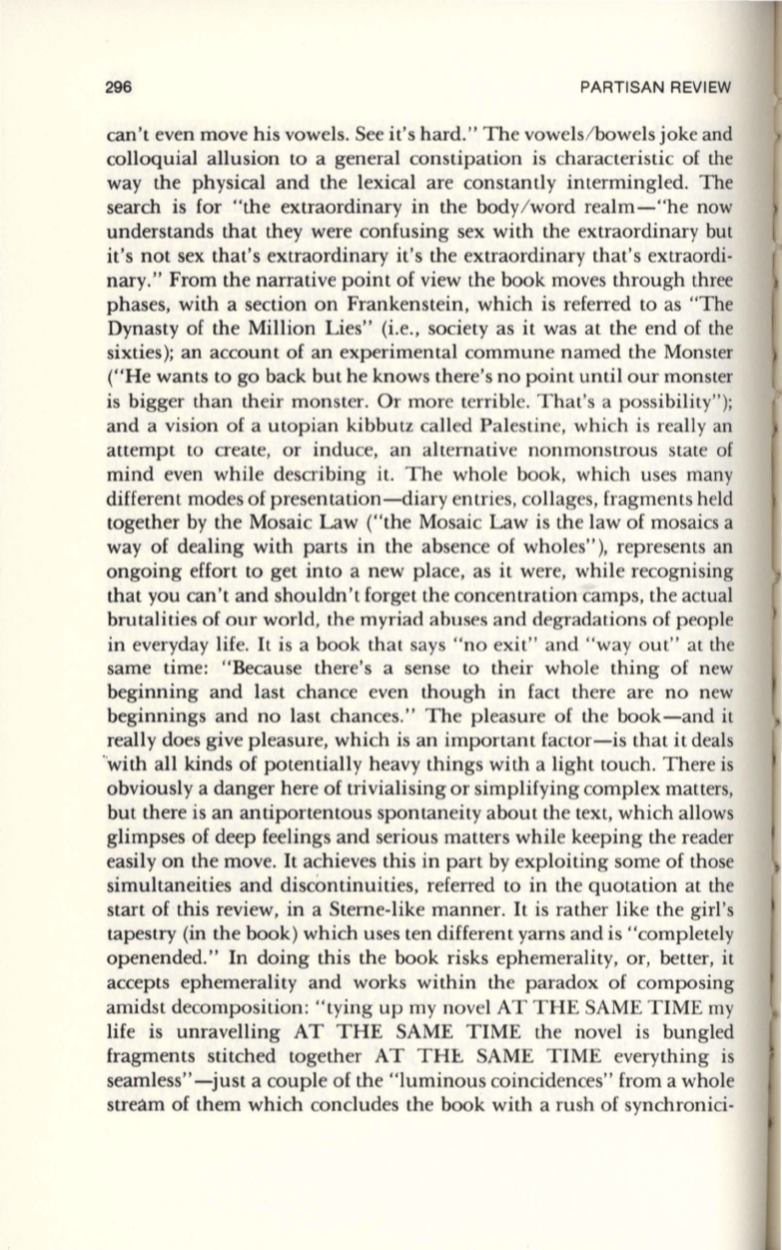
296
PARTISAN REVIEW
can't even move his vowels. See it's hard." The vowelslbowels joke and
colloquial allusion to a general constipation is characteristic of the
way the physical and the lexical are constantly intermingled. The
search is for "the extraordinary in the body/ word realm-"he now
understands that they were confusing sex with the extraordinary but
it's not sex that's extraordinary it's the extraordinary that's extraordi–
nary." From the narrative point of view the book moves through three
phases, with a section on Frankenstein, which is referred to as "The
Dynasty of the Million Lies" (i.e., society as it was at the end of the
sixties); an account of an experimental commune named the Monster
("He wants to go back but he knows there's no point until our monster
is bigger than their monster. Or more terrible. That's a possibility");
and a vision of a utopian kibbutz called Palestine, which is really an
attempt to create, or induce, an alternative nonmonstrous state of
mind even while describing it. The whole book, which uses many
different modes of presentation-diary entries, collages, fragments held
together by the Mosaic Law ("the Mosaic Law is the law of mosaics a
way of dealing with parts in the absence of wholes"), represents an
ongoing effort to get into a new place, as it were, while recognising
that you can't and shouldn't forget the concentration camps, the actual
brutalities of our world, the myriad abuses and degradations of people
in everyday life.
It
is a book that says "no exit" and "way out" at the
same time: "Because there's a sense to their whole thing of new
beginning and last chance even though in fact there are no new
beginnings and no last chances." The pleasure of the book-and it
really does give pleasure, which is an important factor-is that it deals
"with all kinds of potentially heavy things with a light touch. There is
obviously a danger here of trivialising or simplifying complex matters,
but there is an antiportentous spontaneity about the text, which allows
glimpses of deep feelings and serious matters while keeping the reader
easily on the move. It achieves this in part by exploiting some of those
simultaneities and discontinuities, referred to in the quotation at the
start of this review, in a Sterne-like manner.
It
is rather like the girl's
tapestry (in the book) which uses ten different yarns and is "completely
openended." In doing this the book risks ephemerality, or, better, it
accepts ephemerality and works within the paradox of composing
amidst decomposition: "tying up my novel AT THE SAME TIME my
life is unravelling AT THE SAME TIME the novel is bungled
fragments stitched together AT THE SAME TIME everything is
seamless" -just a couple of the "luminous coincidences" from a whole
stream of them which concludes the book with a rush of synchronici-


